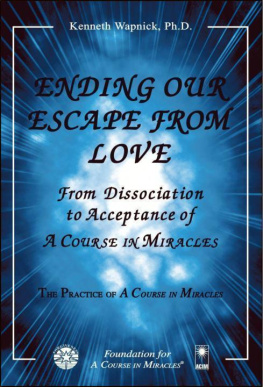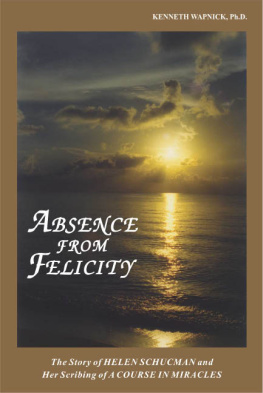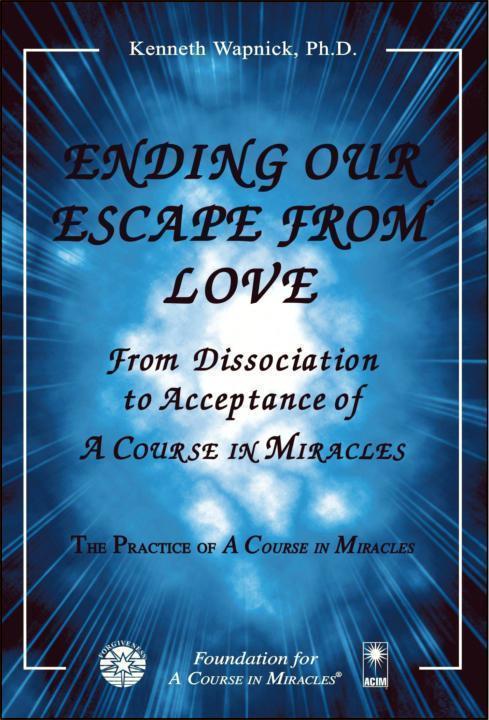From Dissociation to Acceptance of A Course in Miracles
THE PRACTICE OF A COURSE IN MIRACLES
From Dissociation to Acceptance of A Course in Miracles
KENNETH WAPNICK, PH.D.




.......................................... ix
.................................. I
..................................................... 1
...................................... 5
....................................... 9
........................ 13
............................................................. 21
......................................... 21
.................................. 23
................ 35
... 41
............................................. 53
....................................... 85
........................ 105
APPENDIX
................................. 113
....................................... 117
This current book in our series "The Practice of A Course in Miracles" is based on our audio publication Escape from Love: Dissociating A COURSE IN MIRACLES, which consists of an edited excerpt from the 2004 class "The Face of Innocence." For this book, I have expanded the central theme of dissociation to include relevant discussions from two other classes I gave in 2004, which have not been published: "Forgiveness: The End of Dissociation" and "A Course in Miracles: Salvation or Slavation?" (An audio excerpt of the last title has been published as "Looking with Jesus.")
The theme of resistance to A Course in Miracles runs through these excerpts as a thread, and it has been prominent in my teachings over the years. Indeed, it goes to the very heart of students' difficulties with the Course, as this resistance is the source of what appear to be the failures of even its most faithful adherents to learn, let alone practice, the principles of forgiveness and release of judgment. Since this problem is so very prevalent and can be the source of feelings of failure, guilt, and despair over learning how to forgive, it seemed as if it would be helpful to take these excerpts and bring them together into a unified presentation.
Ending Our Escape from Love can be seen as a companion to my earlier book Ending Our Resistance to Love, which also discusses the problem of resistance. I hope that these reminders will inspire students not to lose sight of their goal, even as their fear leads them to defend against it. The gentle path to Atonement begins with recognizing the fear of it, not to mention the love beyond it, and then proceeds with looking without judgment at the defenses (resistance) against our choosing to return home. Thus do the walls of dissociation dissolve and A Course in Miracles allowed to be the means for our accepting the Correction that heralds our awakening from the ego's dream of separation and attaining the End we seek.
These excerpts have been edited to improve their readability and make a seamless fit. The questions that served as a springboard for the discussions of dissociation have not only been edited, but often omitted to permit an easier flow of the material. As is our custom in this series, the writing has been only gently edited to reflect the informality of the actual classes.
The Appendix includes "The Secret Wall," an article in the June 2004 edition of the Foundation newsletter, The Lighthouse, which is relevant to the book's theme. It is largely based on excerpts from an Academy class held at the Foundation called "Forgiveness vs. Forgiveness-to-Destroy." We have also included in the Appendix Helen's poem "Stranger on the Road," which is discussed in the book.
Acknowledgments
Our Director of Publications, Rosemarie LoSasso, carefully preserved the excerpts on which this book is based, and then remarkably pulled them together into a unified whole. This was in addition to her, as always, caring and faithful preparation of the manuscript as it went through its various stages. My gratitude to her is as constant and heartfelt as has been her faithfulness to A Course in Miracles and our Foundation's work.
My wife Gloria provided her usual wonderful editorial advice and assistance, without which the book would not have achieved its final form. As I have written before, these "little books" were her inspiration, and each new publication renews my undying gratitude for her help, not only with these books, but for her consistent love and support for my work over almost thirty years, making it all possible. Love is indeed the way I walk in gratitude for such a sublimely noble woman.
Introduction
It is important when we work with A Course in Miracles over a period of many years to realize that there is a part of us that is split off, or to use the psychological term, dissociated. On the one hand, we have heard and read the words of the Course over and over, and the thought system makes more and more sense as the months and years of study and practice pass by. Yet, something very peculiar happens. It is almost as if a wall has been erected inside us so that there has been no carryover or direct experiential meaning in our personal lives of what we have learned and understood. In other words, we blithely go on living our lives angry and critical, indulging our specialness, getting sick and running to the doctor, and generally doing everything that normal people do-as if nothing we have studied, learned, and sworn by in this course has had an effect. It is as if there is a part of us that believes in truth, and a completely different part that lives our everyday lives as bodies dealing with all the issues our bodies are confronted with. The two parts seem totally unconnected.
It is very important as students of this course that we look at this honestly. So many of us who have been with this thought system for a long time will utter a complaint along the lines of, "When am I going to get it! When is everyone else going to get it!" What is being reflected in that is this strange dissociation that we all practice-as if, so to speak, the right hand does not know what the left hand is doing, or the right brain does not know what the left brain is doing, or the right mind does not know what the wrong mind is doing. However it is described, there is a serious split, and looking at this split or this wall is a way of understanding what Jesus means when he asks us to be honest with him and to hold nothing back (T-4.111.8:2). It makes perfect sense that we would have a wall, because this material is extremely threatening. This gets said over and over, but it appears as if we do not let it get through to us. At some point we have to address that in ourselves. We must look at it, not just intellectually, but we must try to feel what it is we do that keeps what we know to be true from permeating our lives.










